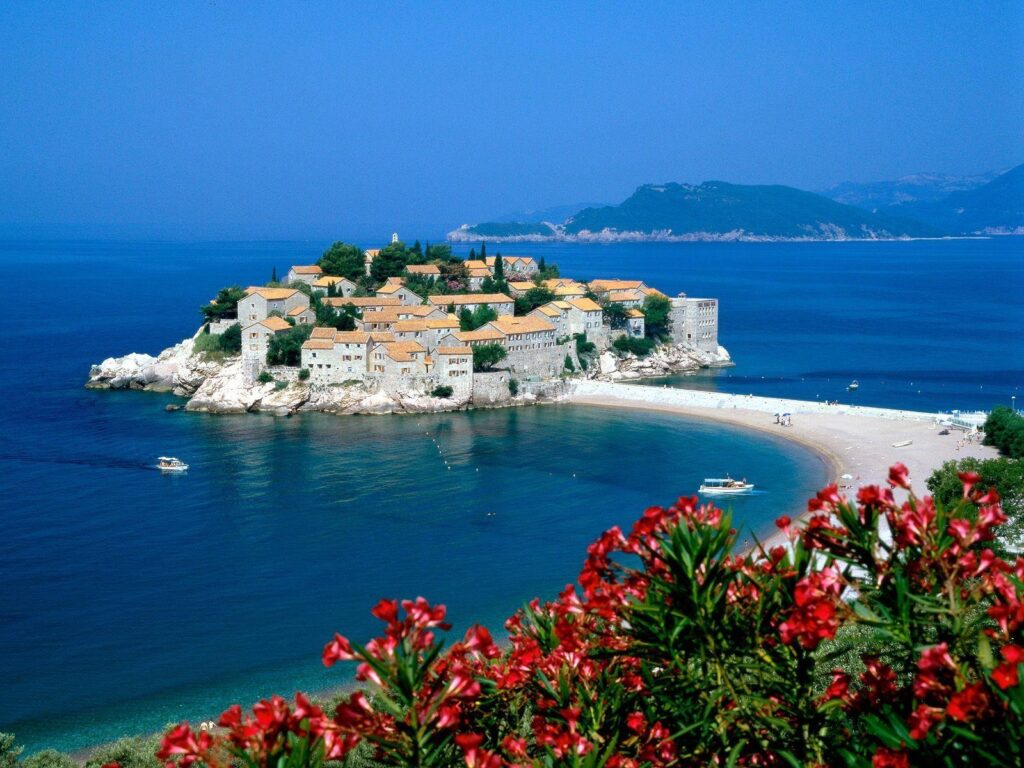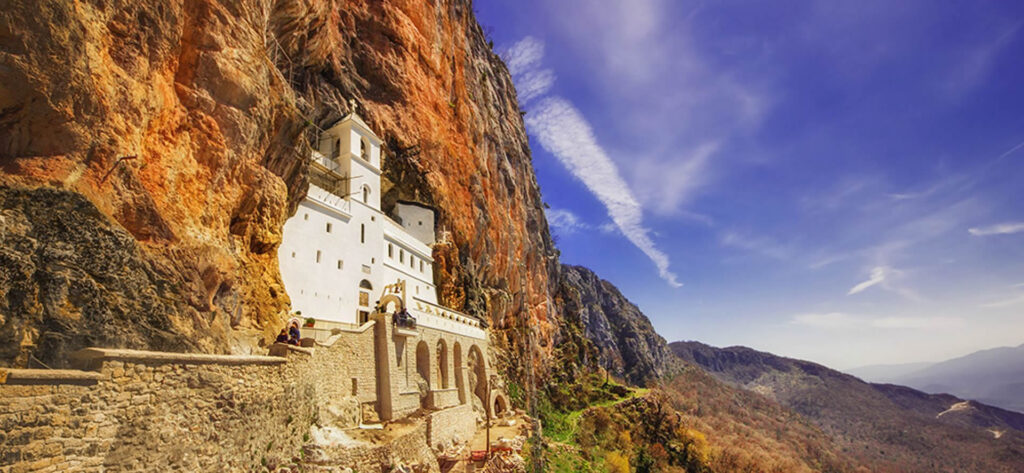Montenegro, also known as the Pearl of the Mediterranean. Montenegro is on the Adriatic coast lying just to the south of Croatia, beautifully preserved medieval towns and historic monasteries.
Montenegro offers a large variety of adventurous and cultural attractions.
Seas, lakes, canyons and mountains make up this stunning country. The coastline is 295 km with 72 km lined in beaches. Sail the Gulf of Kotor, or Boka Kotorska Bay where you will be engulfed by history.
Hike up the mountains of one of the five national parks and get an exquisite view of Montenegro.
Montenegro is a country where you can be surrounded by history and also relax at a exquisite resort.
From sandy beaches to relax in the sunny weather to mountains to hike and see natural habitats and history, there is something for everyone to enjoy.
Travellers and boat owners who will reach this port will come across impressive waterfronts, turquoise waters and a luxuriant vegetation.
The nautical village has almost everything a tourist might look for: sports clubs, hotels, heritage collections and a yachting school. The town of Tivat is a charming settlement surrounded by the imposing Mount Vrmac which offers this area a picturesque aspect.
Opulent hotels and guesthouses, friendly restaurants and an incredible gastronomy based on seafood and Mediterranean dishes welcome its guests into this paradisiacal environment.
Porto Montenegro Marina is also known as Marina Montenegro, and it is a luxury marina that is hosted by the coastal town of Tivat, on the charming shores of the Adriatic Sea. Porto Montenegro Marina offers 450 berths and could accomodate yachts and megayachts up to 250 m in length.
Located in the beautiful UNESCO protected Bay of Kotor, Porto Montenegro Marina combines a spectacular must see destination with a world-class marina and services. Porto Montenegro Marina is a astonishing balance of a true taste, sense of freshness, unique nature, history and avant-garde solutions.

was a fishing village in the 14th century which was erased flat during a Turkish war and rebuilt in the 16th century by the Venetian Republic who ruled the area at the time.
The island resort where wealthy guests stay at today was built then and refurbished in 2007. Thick walled fishermen cottages, stone houses, red tiled roofs traditional of Montenegro, and fortress walls were all built in the 16th century to protect the island from invading Turkish armies.
In the 16th century, the island was inhabited by 12 families but grew to about 400 people in the 18th century. An ismuth (a narrow piece of land connecting two larger areas across an expanse of water) was built later to connect the island to the mainland and has been maintained up to today.
The Yugoslav government bought the entire village and relocated the families to the mainland in the 50s when the island was turned into a luxury resort.
Solitude and peace, silence, disturbed only by the noise of the waves, the smell of pine needles in the salty air, warm stones under your feet and the boundless starry sky above your head is Sveti Stefan. Sveti Stefan is the most luxurious hotel on the Montenegrin coast on a small stone island a couple of nautical miles from the city of Budva.
Durmitor is National Park of Montenegro covering 39000 ha and massif in Northwestern Montenegro that reaches a height of 2,522 meters /stunning Bobotov Kuk peak. The breathtaking Durmitor National park was formed by glaciers and is traversed by number of clean fast rivers and underground streams. The massif of Durmitor Mountain is bordered by the gorgeous Tara River Canyon on the north, outstanding Piva River Canyon on the west, and by the challenging Komarnica River Canyon on the south. To the east, Durmitor National Park is open to a vast 1500 meter high plateau called Jezerska Površ (Plateau of Lakes). Sinjajevina Mountain is located to the east of Jezerska Površ Plateau.
Durmitor mountain range is for the most part located in Zabljak Municipality, one of the highest populated place in the Balkans (1450 m), which features diversified accommodation facilities and tourist infrastructure. Durmitor Mountain features 18 scenic glacial lakes scattered over mountain massif and the Jezerska Površ plateau.
The lakes add significantly to the beauty of the Durmitor Mountain, and have been nicknamed Gorske Oči, or Mountain Eyes. They are Crno Lake, Veliko Škrčko Lake, Malo Škrčko Lake, Zeleni Vir, Jablan Lake, Valovito Lake, Vir u Lokvicama, Srablje Lake, Modro Lake, Suva Lokva Lake, Zminje Lake, Barno Lake, Pošćensko Lake, Zabojsko Lake, Vražje Lake, Riblje Lake, Zminčko Lake and Sušičko Lake.
Perast is an old town on the Bay of Kotor in Montenegro. It is situated a few kilometres northwest of Kotor. Perast is the best preserved Montenegrin Baroque city.
The first settlements appeared in the region of Perast in the Neolithic Age; there are also memorials of Illyrian, Roman, and early Christian periods. The city itself was founded by the Illyrians and named in honor of one of the local tribes – pirusts.
The first mention of Perast refers to 1336 – at this time it was a small fishing village, which nevertheless has a shipyard, and the pier there always were several trading and fishing vessels. But since the nearby strategically important island of St. George belonged to Kotor, Perast development went very slowly.
Prosperity to the city was brought by the Venetian period, and the special significance of the border town it acquired around 1482 – after the capturing by the Turks the part of the coast from Herceg Novi to Risan. When the small settlement finally became a city. The modest facade hides the majestic interior decoration, consisting of a wooden ceiling and marble carved altars in the Baroque style.
Opposite Perast there are two stunning islands – the natural one of St. George and the man-made island Gospa od Škrpjela. On the island of St. George there is an old cemetery and a Benedictine monastery, the mention of which is found for the first time in 1166, relating to Kotor. But, unfortunately, you cannot visit this island on ordinary tourist boats, but by renting a private one. In this case, you cannot enter the monastery, its doors are open only to the inhabitants of Perast.
is on the central part of Montenegrin coast, called “Budvanska Rivijera”. It has developed around a small peninsula, on which the old town is situated. It is by far most visited destination in Montenegro, attracts tourists from all over the world with an old town, bars and nightclubs, and beaches mostly consisting of small rocks. It is base for mass tourism, while in its near vicinity there are luxury resorts such as Sveti Stefan and Miločer.
There are as many as 35 beaches in the Budva area, mostly rock and a little sand (8 beaches are marked with blue flags).
Budva is a coastal tourist resort in Montenegro. It is often called “Montenegrin Miami”, because it is the most crowded and most popular tourist resort in Montenegro, with beaches and vibrant nightlife.
There is an amazing promenade that stretches throughout coast of municipality but end to end of the city can be reached within 20 minutes, and it would be a shame to miss walking down the promenade and all of its surrounding beauties.
There are many tourist boats that dock in Budva harbor which offer rides to nearby beaches, Sv. Nikola island, or one-day trips to various destinations on Montenegrin coast.
One of the most attractive parts of city is Stari Grad (Old Town) (on the peninsula in Budva center). The old town of Budva lies on a little island that was linked to the land by a sandbar and in time turned into a peninsula. It is surrounded by ramparts originating from the 15th century including a medieval fortification system with city gates, defense walls and towers. The Old Town consists of narrow streets and alleys and small squares with precious monuments of different Mediterranean cultures that have marked the development of this town. You can enter in Old Town from one of five entrance doors.
The Old Town of Kotor lies in the shadows of the St. Jovan’s Hill and the walls protecting this town are a fortification masterpiece at up to 15 meters wide and 20 meters high each. These walls are skillfully crafted into the natural steep slopes of the hill and the view of this town on approach is one of the amazing sights, not only of the Mediterranean, but of the world.
Visiting Kotor is about more than beautiful views—it’s also about experiencing the cultural heritage of Boka Kotorska Bay.
It is believed that the roots of Kotor stretch back before Homer (10-12 BCE), a time when Phoenicians ruled the Mediterranean. This means that Kotor is an ancient city, as old as the sea trade in the Adriatic.
The layers of history prove that construction of palaces and dwellings was not the only skill in this town. Seafaring, as well as artistry, weaponry and goldsmithing were equally popular trades in Kotor.
Today, Kotor is on UNESCO’s list of world heritage sights due to its yield of historic figures including Fra Vito—the architect of the Monastery Dečani, Lovro Marinov Dobričević—icon painter, as well as countless sea captains, diplomats, publishers and poets. In addition, this town preserves another unique feature—it is the only town where the tradition of seafaring unity prevailed and continues on! The Bokeljska mornarica (Navy of Boka Kotorska Bay) has been active for more than twelve centuries and still uses its original traditional admiral, clothing, dance and ceremonies.

is a monastery of the Serbian Orthodox Church located near an almost vertical cliff, high on the mountain Ostroška greda in Montenegro. It is dedicated to Saint Vasilije Ostroski. Ostrog Monastery consists of Upper and Lower Monasteries.
It belongs to the municipality of Danilovgrad and is located in a vertical rock, from where you can see the Plain of Bjelopavlic.
The summit offers a magnificent view of the Bjelopavlic Plain and is the most important place of pilgrimage in Montenegro. The complex consists of two parts, the first of which is the larger Lower Monastery, located around the Holy Trinity Church, built in 1824, around which most of the monastery buildings, including the konak.
The white, upper monastery, built into the rock, is reached by an ascending path, three kilometers long, leading uphill, to two small cave churches. One is dedicated to the Holy Cross and is magnificently painted with frescoes.
The Ostrog Monastery was founded in the 17th century by Metropolitan Vasilije Ostroški of Herzegovina, who was Bishop Zahumsko-Herzegovinian from 1639 to 1671. Bishop came with the monks to this remote place, from the Tvrdoš Monastery in Herzegovina, which was destroyed by the Turks. He died in 1671 and after two years was consecrated.
His body, the holy relics, is in a coffin in the cave church of the Ostrog Monastery, dedicated to the Entrance of the Virgin into the temple (the Presentation of the Holy Virgin).